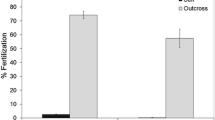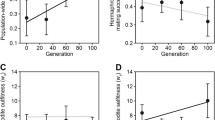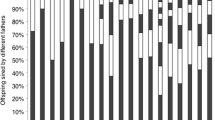Abstract
The clam shrimpEulimnadia texana is an androdioecious crustacean in which hermaphrodites may self fertilize or outcross with males but cannot outcross with other hermaphrodites. Outcrossing is maintained within most populations of this species despite the high genetic cost of sex, suggesting that compensating factors provide an advantage to outcrossing. We hypothesized that one such benefit would be the production of larger clutch sizes resulting from outcrossed matings. To test this prediction, we recorded the body sizes and clutch sizes of hermaphrodites which mated via selfing or bia outcrossing. Clutch sizes showed significant, almost exponential, increases as body size increased in both selfing and outcrossing hernmaphrodites. The rate of this increase was the same for both groups, and there was no significant difference in clutch size when body size was controlled for between the two fertilization types.
Similar content being viewed by others
References
Baur, B., 1989. Growth and reproduction of the minute land snailPunctum pygmaeum (Draparnaud). J. Moll. Stud. 55: 383–387.
Belk, D., 1972. The biology and ecology ofEulimnadiaantlei Mackin (Conchostraca). Southwest. Nat. 16: 297–305.
Charlesworth, B., 1980. The cost of sex in relation to mating system. J. Theor. Biol. 84: 655–671.
Jarne, P., L. Finot, B. Delay & L. Thaler, 1991. Self-fertilization versus cross-fertilization in the hermaphroditic freswater snailBulinus globosus. Evolution 45: 1136–1146.
Knoll, L., 1995. Mating behavior and time budget of an androdioecious crustacean,Eulimnadia texana (Crustacea: Conchostraca). Hydrobiologia 298 (Dev. Hydrobiol. 103): 73–81.
Knoll, L. & N. Zucker, 1995. Is sexual selection operating in the androdioecious clam shrimp,Eulimnadia texana (Crustacea: Conchostraca)? Hydrobiologia 298 (Dev. Hydrobiol. 103): 67–72.
MacKay, W. P., S. J. Loring, T. M. Frost & W. G. Whitford, 1990. Population dynamics of a playa community in the Chihuahuan desert. Southwest. Nat. 35: 393–402.
Otto, S. P., C. Sassman & M. W. Feldman, 1993. Evolution of sex determination in the Conchostracan shrimpEulimnadia texana. Am. Nat. 141: 329–337.
Sassaman, C., 1988. Clutch sex-ratio polymorphism in the clam shrimpEulimnadia antlei. Am. Zool. 28: 135A.
Sassman, C., 1989. Inbreeding and sex ratio variation in female-biased populations of a clam shrimp,Eulimnadia texana. Bull. mar. Sci. 45: 425–432.
Sassman, C. & S. C. Weeks, 1993. The genetic mechanism of sex determination in the Conchostracan shrimpEulimnadia texana. Am. Nat. 141: 314–328.
Strenth, N. E., 1977. Successful variations of sex ratios inEulimnadia texana Packard (Crustacea, Conchostraca). Southwest. Nat. 22: 205–212.
Author information
Authors and Affiliations
Rights and permissions
About this article
Cite this article
Knoll, L., Zucker, N. Selfing versus outcrossing in the androdioecious clam shrimp,Eulimnadia texana (Crustacea, Conchostraca). Hydrobiologia 298, 83–86 (1995). https://doi.org/10.1007/BF00033802
Issue Date:
DOI: https://doi.org/10.1007/BF00033802




